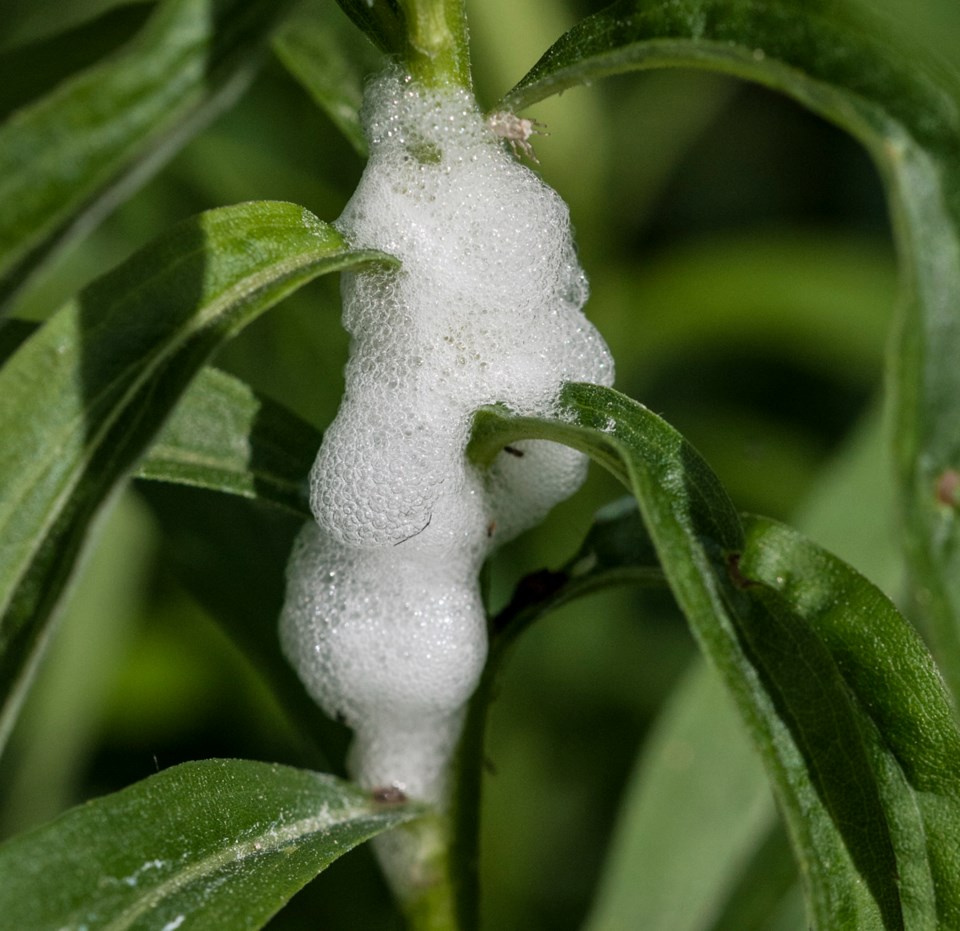If you are wandering about in a tall-grass meadow these days, be prepared to get wet. Rubber boots will help, but a pair of hip-waders might afford better full protection. And it's not the rain I'm warning you about, it's the spit!
Great gobs of spit, huge dollops of spit, glistening masses of spit, all hanging in frothy bundles along plant stems of all descriptions. Try as you might, there is no way you can cross a meadow and stay unscathed. Yet, as icky as it looks, the spit and what it contains is a really quite a neat story.
That wet mass of bubbles is actually a home, at least a temporary home, for a fascinating little insect called a froghopper. And with a name like froghopper, it had indeed better be fascinating.
Froghoppers get their name from the way the adult insects move, in that they hop, frog-like, from leaf to leaf. But it's not the adults we're seeing right now, they're still a couple of weeks away. It's the really gross young ones we're finding in the spit.
Maybe I should address the 'spit' part right now, as some of you may be thinking that this little insect is a tad unrefined in its behaviour. Not so. In fact, the nymph (the stage between egg and adult) is being quite creative to survive being on the menu of passing birds. The spit is actually a cover, a blanket, a way to escape detection. And it's a way to ensure that the creature remains moist and healthy despite the hot sun.
There are different kinds of spittlebugs (as froghoppers are called when they are in the nymph stage), some species preferring alfalfa, others coarse grasses and at least one kind that likes to nestle within the needles of Scotch pine.
Of note is that the pine tree variety usually start at the tips of the branches and slowly move towards the trunk as they get older; by the time they are ready to emerge as adults there may well be a dozen or more of them clustered together on the soft bark.
To make the gooey stuff, spittlebugs use a series of tubes on their body called Malpighion tubes, which are attached to the alimentary canal and can vary in number from two to over 150. These tiny tubes are mainly used to take substances from the body cavity, mixing them with the urine they secrete and discharging the whole into the hind intestine to be passed out in the feces.
Cockroaches and moths have these tubes, but the froghopper has found a way to utilize them in a more constructive manner.
As the plant's sap is ingested by the sucking mouthpart, it is excreted by the Malpighian tubes but with air now being pumped into the mess. The addition of the air creates the meringue topping in which the nymph is protected from enemies and desiccation.
To ensure that they are properly covered, the nymphs position themselves head down on the stem, thus allowing the bubbly mixture to flow over them, leaving them tucked safely inside.
Despite the above description of how the bubbles are formed, I often take a finger and smear the bubbles away to see the little guy inside.
The nymphs found on grasses are an emerald green with tiny black eyes; the pine tree nymphs are a darker colour, again closely matching the host plant. Heavy rain washes the spittle away, so they must have a way to hide when the weather removes their protective cover.
As soon as the air clears, they make a new protective shield of sap, air and unmentionable stuff. (Maybe I'll use a stick instead of my finger from now on.)
Some spittlebugs can be a pest to crops if their populations get too high; other species can impede the growth of pines. Although predators such as chickadees and kinglets pick off a few, it is a deadly fungus that keeps most populations in check. There are even itty bitty wasps that lay their eggs on the adult froghoppers, a rather gruesome way to ensure a food source for their own growing young.
So next time you're out and about, wandering through a meadow or pine grove, take a moment to stop and explore (with a stick) the marvel of nature known as the spittlebug.



